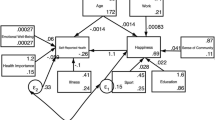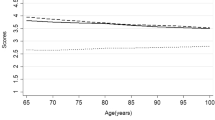Abstract
We investigate the nexus between poverty of sense of life (a dimension of eudaimonic subjective wellbeing) and mortality in a large sample of individuals from several European countries. We find that poverty of sense of life is significantly and positively correlated with mortality, net of the impact of socio-demographic factors, life styles, symptoms and even life and health satisfaction controls. We as well test whether the observed correlation is mainly explained by physiological factors or, as well, by behavioural factors such as unhealthy life styles and/or insufficient physical activity.

Similar content being viewed by others
Notes
SHARE was created following a Communication by the European Commission calling to "examine the possibility of establishing, in co-operation with Member States, a European Longitudinal Ageing Survey". The database became a major pillar of the European Research Area and was selected as one of the projects to be implemented in the European Strategy Forum on Research Infrastructures (ESFRI) in 2008. The project has been given the status of the first ever European Research Infrastructure Consortium. The research is harmonized with the US Health and Retirement Study (HRS) and the English Longitudinal Study of Ageing (ELSA) and adopts rigorous methodologies that ensure and ex-ante harmonized cross-national design.
Note that the maintained hypothesis in this literature for a nexus between this commonly used variable and the wider concept of eudaimonic wellbeing is that getting closer to one’s own self-fulfillment progressively increases one’s own sense of life. Hence the two variables are expected to be strictly positively correlated.
We alternatively use 1997 ISCED (International Standard Classification of Education) standards and, specifically, dummies for primary education or first stage basic education, lower secondary or second stage of basic education, (upper) secondary education, post-secondary non-tertiary education, first stage of tertiary education, second stage of tertiary education (with pre-primary education being the omitted benchmark). Results are not substantially different and do not exhibit particular nonlinearities in the relationship between education degrees and the number of pathologies. The more parsimonious specification with the number of education years is therefore preferred.
As is well-known the SHARE dataset presents several missing-values for some variables such as income. Following what is standard for research on this database we use the supplementary datasets downloadable from the SHARE website where the missing information is imputed by Christelis (2011) using Fully Conditional Specification method (FCS) (Van Buuren et al. 2006). In its Frequently Asked Question page SHARE discusses the use of imputed data. Its suggestion is to take into account of the variability of the different five imputations since they are five independent draws from the estimated distribution of missing values. The less advisable solution is therefore that of choosing one imputation among the five. The more advisable solutions are those of using averages of the five imputed values or performing a robustness check using alternatively the different imputations (http://www.share-project.org/group-faq/faqs.html). The use of averages of the five iterations is a common approach. The differences are very small, and nothing changes in our findings if we choose one of the five iterations instead of the average. Findings on a robustness check using each time one of the different imputations are omitted for reasons of space.
As is well-known several different measures of equivalised income have been developed in the literature to account for household economies of scale according to the different age structure of members (Schwarze 2003). The use of different scales however produces negligible effects on our main findings and we therefore remain on the simpler per capita income variable. Evidence is omitted for reasons of space and available upon request.
According to the standard international classification the underweight class starts below a body mass index of 18.5, the overweight class above 24.99 and the obese class above 30.
As shown in Bachelet et al. (2016) the question on diagnosed pathologies is different in wave 1 with respect to waves 2 and 4 of the SHARE survey and this creates problems of homogeneity in this important regressor in our analysis.
As is well known mortality rates of different types of cancer are extremely variable, being highest for pancreas cancer and lowest for thyroid and testicle cancer. For reasons of simplicity we here provide an average estimate since the question is out of the specific focus of our paper.
Central-Southern Europe: Austria, France, Switzerland, Spain and Italy; Central-Northern Europe: Germany, Sweden, The Netherlands, Denmark, Belgium, Eastern Europe: Czechia, Slovenia, Estonia.
References
Aristotle. (1962). The Nichomachean ethics, translated by Martin Oswald. New York: The Bobs-Merrill Company.
Au, N., & Johnston, D. W. (2014). Self-assessed health: What does it mean and what does it hide? Social Science and Medicine, 121, 21–28.
Becchetti, L., & Pelloni, A. (2013). What are we learning from the life satisfaction literature? International Review of Economics, 60(2), 113–155.
Bachelet, M., Becchetti, L., & Riccardini, F. (2016). Not feeling well...true or exhaggerated? Self-assessed health as a leading health indicator. Health Economics, 27(2), 153–170.
Boyle, P. A., Barnes, L. L., Buchman, A. S., & Bennett, D. A. (2009). Purpose in life is associated with mortality among community-dwelling older persons. Psychosomatic Medicine, 71(5), 574.
Christelis, D. (2011). Imputation of missing data in waves 1 and 2 of SHARE. CSEF, Naples Working Paper no. 278.
Clark, A. E., Frijters, P., & Shields, M. A. (2006). Income and happiness: Evidence, explanations and economic implications. Paris Jourdan Sciences Economiques, working paper 2006–2024.
Cohen, R., Bavishi, C., & Rozanski, A. (2016). Purpose in life and its relationship to all-cause mortality and cardiovascular events: A meta-analysis. Psychosomatic Medicine, 78(2), 122–133.
Cutler, D. M., Deaton, A., & Lleras-Muney, A. (2006). The determinants of mortality NBER working paper no. 11963. Cambridge, MA.
Doiron, D., Fiebig, D. G., Johar, M., & Suziedelyte, A. (2015). Does self-assessed health measure health? Applied Economics, 47(2), 180–194.
Fredrickson, B. L., Grewen, K. M., Coffey, K. A., Algoe, S. B., Firestine, A. M., Arevalo, J. M., et al. (2013). A functional genomic perspective on human well-being. Proceedings of the National Academy of Sciences, 110(33), 13684–13689.
Frey, B., & Stutzer, A. (2002). What can economists learn from happiness research. Journal of Economic Literature, 40, 402–435.
Hill, P. L., & Turiano, N. A. (2014). Purpose in life as a predictor of mortality across adulthood. Psychological Science, 25(7), 1482–1486.
Judge, T. A. (1992). Job satisfaction and subjective well-being as determinants of job adaption. Academy of management proceedings (Vol. 1992, No. 1, pp. 222–226). New York: Academy of Management.
Judge, T. A., Thoresen, C. J., Bono, J. E., & Patton, G. K. (2001). The job satisfaction—job performance relationship: A qualitative and quantitative review. Psychological Bulletin, 127(3), 376.
Keyes, C. L. (2011). Authentic purpose: The spiritual infrastructure of life. Journal of Management Spirituality and Religion, 8(4), 281–297.
Kim, E. S., Strecher, V. J., & Ryff, C. D. (2014). Purpose in life and use of preventive health care services. Proceedings of the National Academy of Sciences of the United States of America, 111(46), 16331–16336.
Koizumi, M., Ito, H., Kaneko, Y., & Motohashi, Y. (2008). Effect of having a sense of purpose in life on the risk of death from cardiovascular diseases. Journal of Epidemiology, 18(5), 191–196.
Krause, N. (2007). Longitudinal study of social support and meaning in life. Psychology and Aging, 22(3), 456.
Krause, N. (2009). Meaning in life and mortality. The Journals of Gerontology Series B Psychological Sciences and Social Sciences, 64(4), 517–527.
OECD. (2013). OECD guidelines on measuring SWB. Paris: OECD Publishing. https://doi.org/10.1787/9789264191655-en.
Park, C. L. (2007). Religiousness/spirituality and health: A meaning systems perspective. Journal of Behavioral Medicine, 30(4), 319–328.
Ryff, C. D., & Keyes, C. L. M. (1995). The structure of psychological well-being revisited. Journal of Personality and Social Psychology, 69(4), 719.
Ryff, C. D., Singer, B. H., & Love, G. D. (2004). Positive health: Connecting well-being with biology. Philosophical Transactions-Royal Society of London Series B Biological Sciences, 2004, 1383–1394.
Salovey, P., Rothman, A. J., Detweiler, J. B., & Steward, W. T. (2000). Emotional states and physical health. American Psychologist, 55(1), 110.
Schulz, A., & Doblhammer, G. (2011). Longitudinal Research with the Second Wave of SHARE: Representativeness of the longitudinal sample and the mortality follow-up. Rostock center discussion paper 28 Rostock center for the study of demographic change.
Schwarze, J. (2003). Using panel data on income satisfaction to estimate equivalence scale elasticity. Review of Income and Wealth, 49(3), 359–372.
Sone, T., Nakaya, N., Ohmori, K., Shimazu, T., Higashiguchi, M., Kakizaki, M., et al. (2008). Sense of life worth living (ikigai) and mortality in Japan: Ohsaki Study. Psychosomatic Medicine, 70(6), 709–715.
Van Buuren, S., Brand, J. P. L., Groothuis-Oudshoorn, C. G. M., & Rubin D. B. (2006). Fully conditional specification in multivariate imputation. Journal of Statistical Computation and Simulation, 76(12), 1049–1064.
Author information
Authors and Affiliations
Corresponding author
Ethics declarations
Conflict of interest
All authors declare that they have no conflicts of interest.
Rights and permissions
About this article
Cite this article
Becchetti, L., Bachelet, M. & Pisani, F. Poor eudaimonic subjective wellbeing as a mortality risk factor. Econ Polit 36, 245–272 (2019). https://doi.org/10.1007/s40888-018-0134-2
Received:
Accepted:
Published:
Issue Date:
DOI: https://doi.org/10.1007/s40888-018-0134-2




